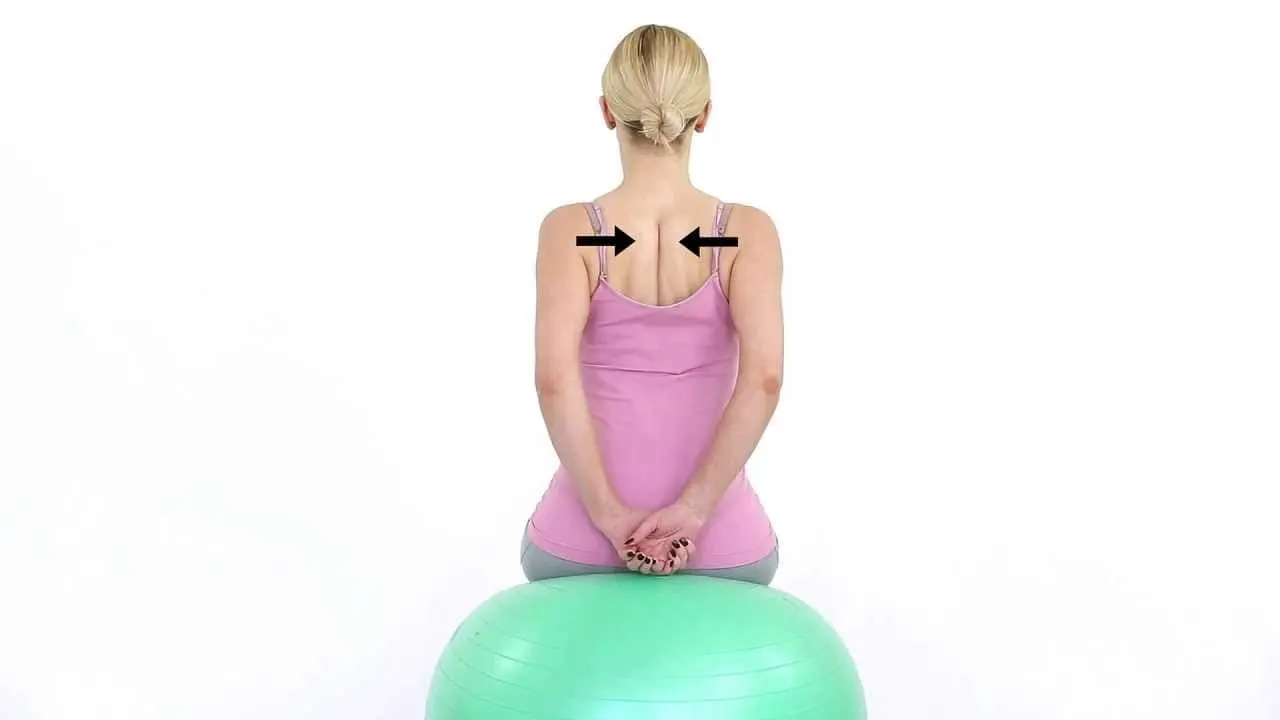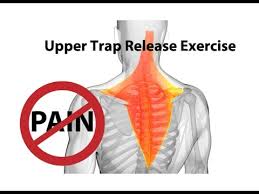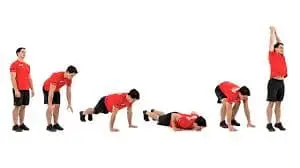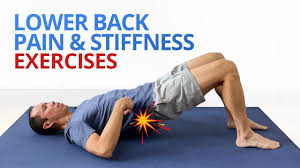17 Best Exercises for Scapula Protraction and Retraction
Introduction
Scapula protraction and retraction exercises play a vital role in improving shoulder stability, posture, and upper body strength. The scapula, or shoulder blade, is involved in many upper body movements, and its proper function is essential for pain-free motion and injury prevention.
Protraction involves moving the shoulder blades away from the spine, while retraction pulls them closer. Strengthening these movements helps improve shoulder mechanics, which can aid in rehabilitation, enhance athletic performance, and prevent musculoskeletal disorders.
By strengthening the muscles that connect to your shoulder blades, these exercises increase the range of motion in both your scapular and shoulder joints. Exercise helps reduce shoulder pain and stop more damage. Your muscles will remain long and flexible with the help of strengthening exercises.
In this guide, we’ll go over the advantages of scapular protraction and retraction exercises, as well as how to put them into your training or recovery routine. Include scapular protraction and retraction exercises in your exercise program if you’re an athlete trying to improve performance, someone with shoulder pain that needs to be relieved, or someone who wants to look better.
Exercise’s advantages:
- Your upper body strength, general well-being, and shoulder mobility can all be greatly improved by including a scapular protraction and retraction exercise in your workout plan.
- These exercises are your first line of defense against stress and exhaustion because they target important muscle groups and encourage good alignment.
- Reduce your pain
- Improve movement
- Improves the scapular mobility
- Increase the range of motion in your overhead posture.
Exercises for Scapula Protraction and Retraction:
The most effective scapula protraction and retraction exercises are listed below.
Bear Hug
- Start by standing in a comfortable position.
- Secure a resistance band by wrapping it around your shoulder blades in the middle.
- At this point, extend your arms straight out to your sides at a 90-degree angle.
- Maintain the longest possible arm extension.
- Then, as though you were hugging someone, pull the band inside and forward.
- Squeeze your shoulder blades.
- Hold this position for a few seconds.
- Then return to your neutral position.
- Then relax.
- Repeat this exercise five to ten times.
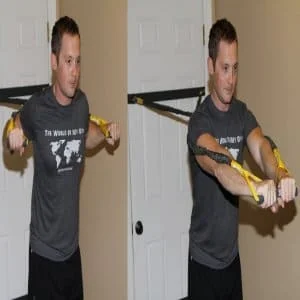
Standing Row
- Begin by standing in a relaxed manner.
- Wrap a steady object in a resistance band or place it inside a door.
- You can grab the band’s end.
- Hold your elbows at a ninety-degree bend.
- Faced toward each other are your palms.
- Next, firmly compress your shoulder blades together.
- Hold this position for a few seconds.
- Then return to your neutral position.
- Then relax.
- Repeat this exercise five to ten times.
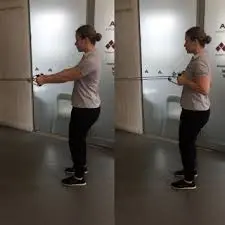
Shoulder shrug
- Beginning by taking a comfortable seat or standing at the table.
- Now elevate your shoulders to the level that feels comfortable for you.
- Place your shoulders over your ears.
- Firmly compress your shoulder blades.
- Hold this position for a few seconds.
- Then return to your neutral position.
- Then relax.
- Repeat this exercise five to ten times.
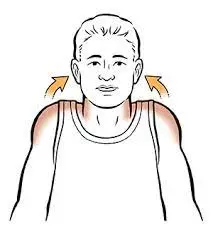
Internal Rotation
- Begin by standing in a relaxed manner.
- Place the band against a door or another object and turn it toward you.
- After that, take hold of the band with your arm.
- Maintain a 90-degree angle with your elbows.
- Next, extend your forearm within your body.
- Gently squeeze your shoulder blades.
- Hold this position for a few seconds.
- Then return to your neutral position.
- Then relax.
- Repeat this exercise five to ten times.
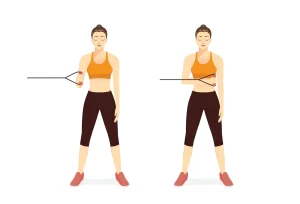
Wall angel
- Place your feet a few inches away from the wall and bend your knees slightly while facing the wall.
- The mid-back leans against the wall with a posterior pelvic tilt, while the lower back presses.
- Pull your chin in slightly and straighten your neck so that your back rests against the wall.
- Put your hands against the wall, press your elbows against it, and raise your arms to a 90-degree angle.
- As you slowly raise your arms above your head, create a Y stance.
- Squeeze your shoulder blades now.
- Make sure that your entire back, head, elbows, and hands stay in touch with the wall as you perform this.
- Then return to your neutral position.
- Then relax.
- Repeat this exercise five to ten times.
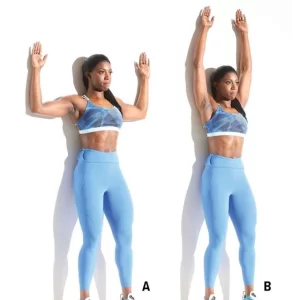
Standing doorway stretch
- First, take a position in the open doorway.
- Bend both of your arms to a 90-degree angle and point your palms ahead while raising them to the side.
- Step one foot forward slowly.
- Squeeze your shoulder blades tightly.
- Avoid stooping or bending forward.
- Hold this position for a few seconds.
- Then return to your neutral position.
- Then relax.
- Repeat this exercise five to ten times.
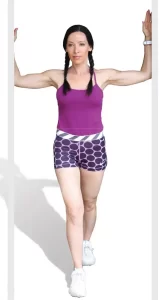
Wall ball rolling exercise
- To begin, place a ball at shoulder height against the wall while standing.
- Squeeze your shoulder blades down and back at this point.
- Roll the ball in tiny circles or slowly raise and lower your hand over it.
- Proceed with the shoulder squeeze motion constantly.
- Hold this position for a few seconds.
- Then return to your neutral position.
- Then relax.
- Repeat this exercise five to ten times.
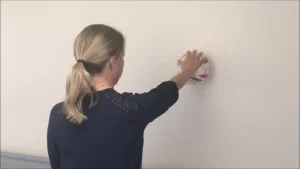
Up-down plank
- Start by lying down on your face.
- Bend your elbows and forearms inside of your body.
- Now raise your hips and chest to a partially planked posture.
- You’re just lying back and supporting yourself with your forearms.
- Then raise your upper back.
- Squeeze your shoulder blades back into your spine after pushing them out the other way.
- Hold this position for a few seconds.
- Then return to your neutral position.
- Then relax.
- Repeat this exercise five to ten times.
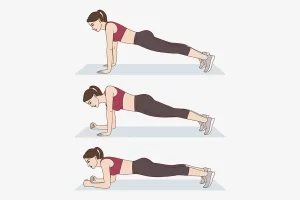
Scapular Squeeze with arm lift
- Start by lying down in a prone position.
- With both arms at your sides, turn your hands inside out.
- Squeeze your shoulder blades together after that.
- Next, raise both arms together.
- Hold this position for a few seconds.
- Afterward, lower your arms.
- Then return to your neutral position.
- Then relax.
- Repeat this exercise five to ten times.
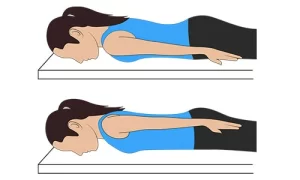
Wall-push-ups
- With a stand facing a wall, begin.
- While raising your arms forward, maintain a straight elbow posture.
- Squeeze both shoulder blades now.
- After that, slowly bend your elbows to move your chest closer to the wall.
- Hold this position for a few seconds.
- As you keep your scapula squeezed.
- Next, push through one more time to bring your hands back to your sides.
- Then return to your neutral position.
- Then relax.
- Repeat this exercise five to ten times.
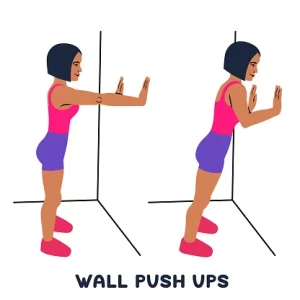
Scapular-protraction-and-retraction
- Place your feet firmly on the floor and take a seat to begin.
- Put a little more weight forward to prevent arching your back.
- Calm down. Maintain alignment in your shoulders, hips, and ears.
- Pull your shoulder blades together and extend your arms back.
- Hold this position for a few seconds.
- Then return to your neutral position.
- Then relax.
- Repeat this exercise five to ten times.
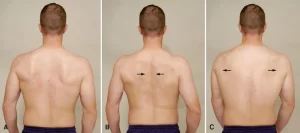
Scapular Retractions “Y” Position
- Start by lying down on the bed in a comfortable prone position.
- Spread your arms wide above your head.
- The thumb looking upward toward the ceiling is maintained.
- Squeeze your shoulder blades.
- Hold this position for a few seconds.
- Your hands ought to go back slowly.
- Then return to your neutral position.
- Then relax.
- Repeat this exercise five to ten times.
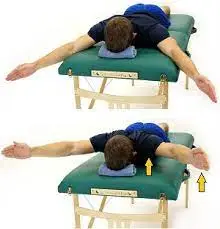
Side-lying external rotation
- Start by lying on your side of the bed with a pillow under your head for support.
- Next, turn your elbow 90 degrees so that your palm faces your body.
- Grasping light dumbbells will give you resistance.
- Take a comfortable position with your forearm raised.
- Squeeze your blades after that.
- Hold this position for a few seconds.
- Bring your forearm down carefully.
- Then return to your neutral position.
- Then relax.
- Repeat this exercise five to ten times.
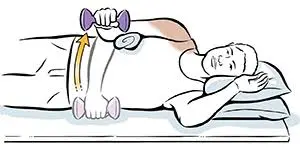
Incline reverse lateral dumbbell raise
- Begin by lying down on a bench in a relaxed state of mind.
- There’s a slight bend in your knees.
- Then, use both hands to hold a dumbbell.
- Place your arms at your sides.
- Now compress the area between your shoulder blades.
- Raise the dumbbell to shoulder height.
- Hold this position for a few seconds.
- Dumbbells are then lowered gradually.
- Then return to your neutral position.
- Then relax.
- Repeat this exercise five to ten times.
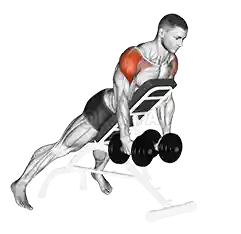
Scapular Retractions “W” Position
- Start by lying on the bed with your face down.
- Maintaining a down palm posture with your elbows bent.
- Pull your shoulder blades downward and back.
- Hold your hands on the bed while you raise your elbows.
- When your hands are up and your forearms are parallel to the bed, stop.
- Hold this position for a few seconds.
- Next, lower your body.
- Then return to your neutral position.
- Then relax.
- Repeat this exercise five to ten times.
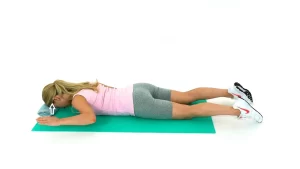
Prone scapula Squeeze
- Start by taking a comfortable prone position on the table.
- Then place a little rolled towel under your forehead.
- With your palms pointing inside, maintain both arms by your sides.
- Squeeze your shoulder blades together.
- You should feel your shoulders lift off the bed as you perform this.
- Hold this position for a few seconds.
- Then return to your neutral position.
- Then relax.
- Repeat this exercise five to ten times.
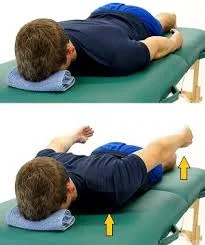
Scapular wall slide
- Place your hand on the wall while you stand comfortably, starting from the floor.
- Now, set a small, light roller against the wall and secure it with your hands.
- Place your front arms against the wall.
- Squeeze your shoulder blades now.
- Gradually raise your forearms up the wall after expanding your elbows.
- Then return to your neutral position.
- Then relax.
- Repeat this exercise five to ten times.
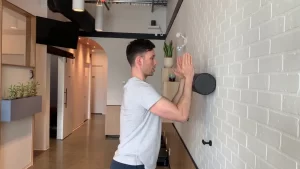
What safety measures are necessary when exercising?
- Warm up and stretch before, during, and after the exercise.
- Stretch, hold, and perform the exercise as recommended.
- Avoid making any sudden or jerky movements when working out.
- Avoid challenging activities.
- Take a break in between each set of exercises.
- It is ideal to work out in loose, casual clothing that allows for maximum range of motion and relaxation. Don’t dress in trendy or tight clothes.
- It’s essential to exercise with proper posture.
- Make sure the equipment you’re using suits properly on you.
- The protocol specifies the correct ordering for performing the suggested amount of repetitions for each exercise, as well as stretches before and between sets.
- Stay hydrated.
When don’t you work out?
- Extreme burning in the muscles
- You feel ill.
- If any numbness or pain is experienced
- If engaging in exercise causes pain, stop.
- Fever
- Headache
Typical Mistakes to Prevent:
While these scapular retraction exercises are helpful, it’s important to avoid typical mistakes that could affect progress.
Some of these mistakes include;
- Putting on too much weight and losing form.
- To get maximum benefit out of these exercise sessions, keep in mind that a good approach is essential.
- Rounding the shoulders when working out.
- Causing poor posture by bending the lower back excessively.
FAQ:
Are scapula strengthened with planks?
The activation ratios and levels of the scapular and shoulder muscles were found to be affected by plank variations. Shoulder rehabilitation can benefit from the use of plank exercises. Plank variations can be increased by changing the elbow position, depending on the individual’s needs.
Which nerve is engaged in the retraction of the scapula?
The muscles of the rhomboid major, rhomboid minor, and levator scapulae are innervated by the dorsal scapular nerve, a motor neuron. These muscles, which are referred to as periscapular stabilizing muscles, have both a collective and dynamic function. Each can elevate and retract the scapula independently.
How can shoulder stability be improved?
While maintaining a standing posture, push your shoulder blades together. As you squeeze, avoid lifting your shoulders. For six seconds, hold.
What is an improved technique for me to rotate my shoulders?
When shoulder abduction is combined with shrug exercise, those with limitations to the scapular downward motion experience improvements in scapular alignment and upward rotation.
What are exercises for strengthening the scapula?
Prone scapula Squeeze
Wall-push-ups
Wall angel
Shoulder shrug
How frequently are scapular protraction and retraction exercises recommended?
You can spend at least 10 to 20 minutes a day performing scapular squeezing exercises.
What advantages come with performing scapular push-ups?
Scapular push-ups are an excellent way to strengthen your shoulders. Ensuring proper alignment of your shoulder blades during upper body movements contributes to improved alignment.
Do these exercises require specific equipment to be done at home?
It is possible to perform numerous scapular retraction exercises with little to no equipment in some cases, just your body weight. But you can mix up your practice and make it more challenging by using equipment like dumbbells or resistance bands.
Will doing workouts that include scapular protraction and retraction help me perform better in sports?
To improve shoulder stability, mobility, and upper body strength all of which are necessary for a variety of sports a solid scapular retraction exercise can help. You can improve your overall performance by including them in your workout regimen.
Are scapular retraction and protraction exercises suitable for all levels of fitness?
It is possible to tailor any scapular retraction exercise to suit different levels of fitness. For beginners, it’s crucial to begin with the correct form and reduce the resistance. To gradually push your muscles as you advance, you can raise the challenge and intensity.
Does retraction of the scapula develop muscle?
Before beginning more hard activities, resistance band scapular retractions are an excellent method to warm up and sharpen your attention. The strengthening of your middle back and upper back muscles will also help.
What symptoms indicate a weak scapula?
Your ability to move your shoulder smoothly and to a greater extent is affected by a reduced range of motion, especially when trying to elevate your arm above your head. Weakness. Tension on one side of your neck occurs as you raise your arm.
References:
- On December 13, 2023b, Bariya, D. The Top 24 Activities to Strengthen and Extend the Scapula – Transportable. Mobile Clinic for Physiotherapy. 24 of the greatest exercises for scapula protraction and retraction are available at https://mobilephysiotherapyclinic.in.
- Launch your debut. July 18, 2024. Muscles Used, Exercises for Scapular Retraction and Protraction, and More. Solutions for Back Muscle. Scapular retraction and protraction: https://backmusclesolutions.com/blogs/the-ql-blawg/srsltid=AfmBOoq9WOseSzQSnAyL5j0XytP5hyHjzttIMXmILtNuUa_sOzmSk9tS
- Ecowise/Aeromat. (2023, August 24). Exercises for Scapular Retraction: Boost Shoulder Mobility and Strengthen Upper Back. Scapular Retraction Exercises: https://www.aeromats.com/blogs/resources
- Image 7, Derby Shoulder Unit (September 23, 2016). Exercise 2d: Push-up position with single-handed crosses [Video]. YouTube. YouTube: https://www.youtube.com/watch?v=JijzZk9VlJE
- Image 12, Explaining Shoulder Pain. (n.d.). How Shoulder Pain Happens After Fifteen Scapular Stabilization Exercises? shoulder-pain-explained.com. Exercises for scapular stabilization: https://www.shoulder-pain-explained.com.html
- Image 15, Get My Patient Well Again. 3 March 2022. W Prone Scapular Positioning [Video]. YouTube. YouTube: https://www.youtube.com/watch?v=Uj-UeOx9Rfw.
- Image 17, C-Coro Chiropractic. April 6, 2020. [Video]: Wall Slide with Foam Roller. YouTube. /watch?v=Q3Q63c0EHZ4

